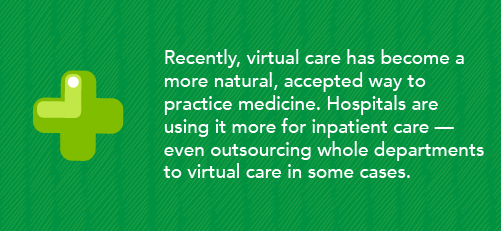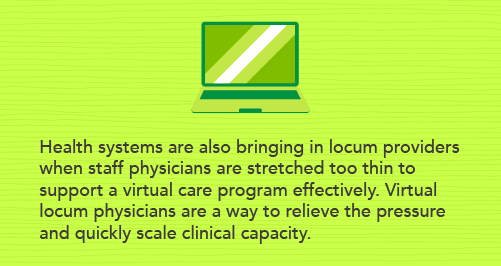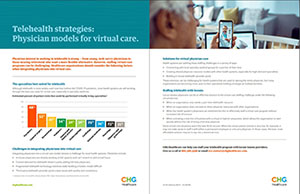
Across the board, physicians are interested in working telehealth — whether they’re young, close to retirement, or simply feeling overloaded and looking for a less stressful alternative. Some providers are even willing to jump to organizations that offer telehealth opportunities, whether it’s part-time, full-time, or gig work. Patient access, lower cost of care, and physician burnout are key reasons why healthcare organizations are developing strategies to integrate physicians into their virtual care models.
A seismic shift in the telehealth landscape
Prior to the COVID-19 pandemic, few physicians were enrolled to work in virtual care — in just a handful of specialties like emergency medicine or psychiatry. Consumers hadn’t embraced it, and health systems weren’t set up to support it, particularly for inpatient and specialty care. Because consumers weren’t clamoring for it, healthcare facilities weren’t eager to invest in the hardware, software, and providers required to support a broad telehealth program.
The pandemic caused a seismic shift that’s forever changed the healthcare landscape. Telemedicine visits soared from .3% or less in 2019 to more than 30% of all visits (some estimate as high as 72%) at the pandemic's peak. Healthcare organizations quickly scaled up their telehealth capabilities, and consumers and physicians rapidly adapted to virtual care.
While usage has dropped since then, over half (54%) of Americans had done a telehealth visit by 2024, and nearly all (89%) were satisfied with their experience.
Recently, virtual care has become a more natural, accepted way to practice medicine. Hospitals are using it more for inpatient care — even outsourcing whole departments to virtual care in some cases. Outpatient providers are also leaning on virtual care wherever it makes sense. The telehealth boom has been especially beneficial to rural patients, who now have better access than ever to specialty care.

Where is telehealth going? Trends in telehealth: The future of virtual care
Best case for virtual physician care
The industry is still determining the best use cases for virtual physician care at the specialty level. Some specialties and patient visits simply make more sense for virtual care than others.
Psychiatry has proved particularly well-suited to virtual care. According to a 2021 Advisory Board analysis on site-of-care shifts, up to 88% of psychiatry visits could be performed virtually. Indeed, by 2024, over half (55%) of mental health visits were virtual.
General surgery presents another opportunity where up to 53% of visits — such as pre-and post-operative visits — could be handled virtually. Cardiology is also gaining traction for virtual care, where an estimated 29% of visits could shift to virtual. Finally, over 40% of dermatology visits could be virtual, according to the Advisory Board.
Convenient care clinics, family physicians, and other outpatient settings are other suitable fits for virtual care.

Challenges in integrating physicians into virtual care
While many specialties may be a natural fit for virtual care, integrating physicians into a virtual care model remains challenging for most health systems.
The biggest obstacle is that most staff physicians are already working at full capacity with in-person visits. Hospitals don’t typically under-leverage specialists to the extent that they can devote even 10 or 20% of their time to telehealth visits. On the other hand, the demand isn’t always there to justify adding a full-time virtual physician either. Realistically, they may only need a .25 FTE — or less. So, the conundrum is that health systems want to do more virtual care, and they want to use their own physicians, but it’s just not always feasible.
Along with patient access, another challenge is that during the pandemic, many departments went out and purchased multiple-point solutions and technologies, leaving hospitals with a jumble of unconnected systems. This fragmentation makes it difficult for hospitals to develop viable and consistent staffing solutions. Additionally, many telehealth technologies come with their own pool of physicians to staff the service, but this can create issues with consistency of process, care quality, and patient experience.
Solutions for virtual physician care
Health systems are tackling these staffing challenges in a variety of ways. Primarily, they are approaching local specialty medical groups and contracting for a portion of their time. Some are banding with other health systems to create shared resource models, where three or four systems share the same virtual specialists.
Both these models are challenging for health systems that are used to employing their own physicians. Traditionally, they’ve wanted to maintain that competitive advantage and prevent their specialists from working for other healthcare organizations. Now, they may feel lucky to have .25 of an in-demand specialist and are more open to them obtaining privileges at multiple facilities.
One of the more innovative models is the creation of an in-house telehealth float pool, which lets the hospital optimize virtual care workloads in real time. It’s an on-demand virtual network that the hospital can access as needed.
As a result of these newer staffing models, we’re seeing some movement away from the fully owned staffing model — full-time salaried employees — toward a triaged model that consists of full-time, virtual, variable staff and independent physicians, all coordinated to optimize gaps in care. Physicians are seeking the ability to moonlight doing virtual care or other additive work, and hospitals are more willing to let them do it.

Many physicians want independence, the ability to compete in an open market for their services, and the flexibility to work the hours and shifts that fit their lifestyles.
Integrating locum tenens physicians into virtual care
Locum tenens physicians are a good solution when an organization only needs a part-time telehealth resource and don’t want to share that resource. Essentially, a locum physician works part time or on demand and serves as a white-label turnkey physician.
Health systems are also bringing in locum providers when staff physicians are stretched too thin to support a virtual care program effectively. Virtual locum physicians are a way to relieve the pressure and quickly scale clinical capacity.

One scenario that is becoming more prevalent is using fully virtual or hybrid locum physicians part time to develop a line of business in a new specialty. This allows the organization to start quickly and either fail fast — without needing to reallocate staff physician resources — or succeed and gradually hire full-time, permanent physicians as the line of business grows.
Some virtual care situations aren’t the best fit for locums. When the virtual patient volume is very low, staffing it with either a permanent employee or a locum physician may not make sense. In those cases, the best, most affordable solution may be to tap into a shared service. For some specialties, like oncology, a long-term relationship with the patient may be critical, making locums a less desirable option.
Virtual physician prognosis
Physicians are the biggest piece of the telehealth puzzle, and many healthcare systems are still struggling to fit them into their virtual care models. However, physicians are eager to participate in telehealth, and they are certainly fielding recruitment inquiries. That’s why health systems need to quickly solidify their virtual care strategies and create new opportunities for more flexibility and balance to keep their physicians happy and engaged.
Download: Telehealth strategies: Physician models for virtual care

Interested in learning more about staffing your telehealth program with locum tenens providers? Give us a call at 866.588.5996 or email ecs.contact@chghealthcare.com.